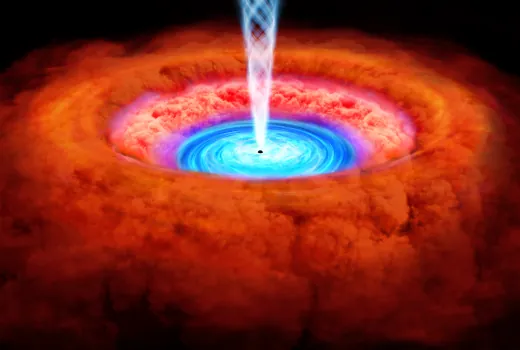
XRISM’s Groundbreaking Discoveries: Unlocking the Secrets of Cosmic Monsters!
2024-09-29
Introduction
In September 2023, the world watched as the joint mission of the Japan Aerospace Exploration Agency (JAXA), the European Space Agency (ESA), and NASA launched the X-Ray Imaging and Spectroscopy Mission (XRISM) into low-Earth orbit aboard a Japanese H-IIA rocket. This state-of-the-art X-ray telescope, now officially operational, is delving into the cosmos, providing vital insights into the structure of the universe, dark matter, and the outflows originating from galaxy nuclei.
Mission Highlights
One of XRISM’s primary missions was to observe black holes and supernova remnants, and it is already making headlines with its groundbreaking findings. The initial scientific data reported marks a significant milestone for the telescope, spotlighting the environments surrounding these enigmatic cosmic phenomena.
Technological Innovations of XRISM
The XRISM telescope is designed to detect high-energy X-ray emissions produced from immensely hot gases encircling supernova remnants and black holes. With its cutting-edge technology, XRISM allows astronomers to explore the speed, temperature, and intricate three-dimensional structures surrounding these cosmic giants. “These new observations provide crucial information in understanding how black holes grow by capturing surrounding matter and offer a new insight into the life and death of massive stars,” stated Matteo Guainazzi, project scientist at ESA.
Observations of N132D Supernova Remnant
Notably, the team focused on the supernova remnant N132D and a supermassive black hole nestled within the galaxy NGC 4151. N132D, which formed following a massive star explosion approximately 3,000 years ago, is located about 160,000 light-years from Earth in the Large Magellanic Cloud. Previous assumptions suggested the remnant took on a spherical shape, but XRISM's observations revealed it has a surprising doughnut-like structure. The telescope measured surrounding gases expanding at an astonishing speed of 1,200 kilometers per second using the Doppler effect.
Groundbreaking Findings About High Temperatures
One of the pioneering technologies aboard XRISM is its Resolve instrument, functioning as a microcalorimeter to detect X-ray photons. This advanced capability revealed extraordinary temperatures within N132D, with iron atoms reaching up to 10 billion degrees Kelvin, a phenomenon produced by the shock waves emanating from the supernova explosion—a first-time observation.
Importance of Supernova Remnants
The implications of the N132D findings are far-reaching. Understanding supernova remnants is crucial as they serve as stellar forges, disseminating elements essential for life throughout the universe. XRISM’s ability to provide clarity on the velocity and temperature distributions of such remnants promises to deepen our understanding of star evolution.
Exploration of NGC 4151 Black Hole
In another exciting development, XRISM explored the black hole within the spiral galaxy NGC 4151, located roughly 62 million light-years from Earth. XRISM’s observations unveiled a mysterious gas structure surrounding a black hole with a mass approximately thirty times that of the Sun. The telescope mapped out three distinct zones of material: the inner accretion disk, the broad line region (BLR), and the outer doughnut-shaped torus. The gas in the accretion disk extends outwards at incredible speeds, some even approaching a few percent the speed of light.
Dynamic Processes of Black Holes
These extraordinary discoveries illustrate the dynamic processes of how black holes “consume” surrounding gas and matter. While similar structures have been previously identified, the unique spectroscopic techniques employed by XRISM set a new precedent within the realms of radio, infrared, and X-ray observations.
Future Endeavors of XRISM
With XRISM’s initial scientific results now available, the teams onboard are not resting on their laurels. Ongoing efforts aim to enhance instrument performance and data analysis methods. A focused list of 60 key observation targets has already been identified, with an additional 104 targets chosen from an impressive array of over 300 proposals submitted by scientists worldwide.
Conclusion
Remarkably, XRISM has exceeded operational expectations in orbit, being hailed as a noteworthy advancement in our quest to unravel the mysteries of the universe. Stay tuned as we follow XRISM’s mission, which promises to revolutionize our understanding of black holes, supernova remnants, and the cosmic dance of the universe!
Featured Image
(Featured image: Artist's impression of the black hole at the center of spiral galaxy NGC 4151. Credit: JAXA)





 Brasil (PT)
Brasil (PT)
 Canada (EN)
Canada (EN)
 Chile (ES)
Chile (ES)
 España (ES)
España (ES)
 France (FR)
France (FR)
 Hong Kong (EN)
Hong Kong (EN)
 Italia (IT)
Italia (IT)
 日本 (JA)
日本 (JA)
 Magyarország (HU)
Magyarország (HU)
 Norge (NO)
Norge (NO)
 Polska (PL)
Polska (PL)
 Schweiz (DE)
Schweiz (DE)
 Singapore (EN)
Singapore (EN)
 Sverige (SV)
Sverige (SV)
 Suomi (FI)
Suomi (FI)
 Türkiye (TR)
Türkiye (TR)